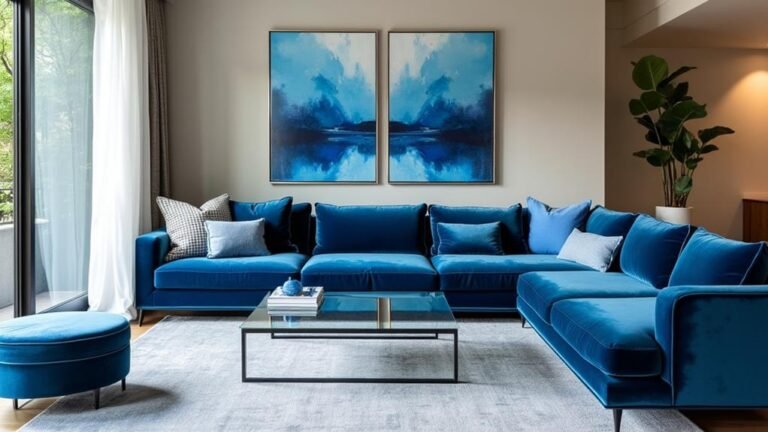5 Things You Didn’t Know About the Psychology of Blue in Interior Design
With the psychology of blue, blue isn’t just another color in your home. It can actually affect how you feel, work, and even understand cultural meanings. Did you know some blues can make you feel calm, while others help you focus better? Understanding these differences can change how you think about decorating your space.
So, what else might blue be doing in your home that you haven’t thought about? Let’s look at some surprising ideas that might change your mind about this color.
Psychology of Blue and Emotional Well-Being

Blue can really boost your mood when you add it to your home. It’s a calm color that makes people feel peaceful. Let’s look at how blue can make your space better:
- Helps You Relax: Light blues create a peaceful feeling, great for bedrooms or quiet spaces.
- Helps You Focus: Dark blues like navy can help you concentrate, perfect for home offices.
- Makes Talking Easier: Soft blues can help people open up, making living rooms better for family time.
You can add blue with paint, decorations, or fabrics. Even a blue pillow or picture can bring this calming color into your home. By using blue, you’ll make your space feel good and support your emotional health.
Cultural Perceptions of Blue

Cultural perceptions of blue differ widely across the world, shaping how we use this color in our homes. Blue can mean different things to different people – it might represent peace in one place and sadness in another. Knowing these differences can help you pick the right blue shades for your space.
Let’s look at some cultural meanings of blue:
- Middle Eastern Cultures: Blue is often seen as a protective color that keeps bad spirits away.
- Western Cultures: People often link blue to calmness and dependability, which is why it’s a popular choice for home offices.
- Indian Culture: Blue is connected to the divine, especially when it comes to Hindu gods and goddesses.
- Chinese Culture: In China, blue represents immortality and is sometimes associated with healing.
Understanding these cultural perspectives can guide you in choosing the right blue for your interior design, whether you’re aiming for a calming atmosphere or a more spiritually significant space.
The Effects of Light on Blue

Light has a big impact on how blue looks in your home. Different types and amounts of light can really change the shade and feeling of blue in your space. Let’s break it down:
Natural Light:
- Sunlight makes blue look bright and fresh
- During sunset, blue can appear softer
Artificial Light:
- Warm lightbulbs give blue a cozy, welcoming feel
- Cool white bulbs can make blue seem more sterile
Room Size:
- In small rooms, bright light can make blue feel more open
- Dim lighting might make blue feel tight in small spaces
These effects are important to consider when you’re choosing blue for your home. The way light interacts with blue can completely change the atmosphere of a room. Keep in mind that the blue you see in a store might look different once you get it home, depending on your lighting setup.
Blue in Different Design Styles

Blue can really make a statement in different interior design styles. Let’s explore how it works in various aesthetics:
- Coastal designs love light blues. They remind us of the ocean and create a breezy, fresh atmosphere. It’s like bringing the beach indoors.
- In modern interiors, deep, bold blues are a hit. They add a touch of class and drama, working well with the clean lines typical of this style.
- Farmhouse decor benefits from soft, muted blues. These shades bring warmth and coziness, perfectly complementing the rustic charm of the style.
- For bohemian spaces, vibrant blues are the way to go. Mix them with fun patterns and interesting textures to create an artistic, lively vibe.
Psychological Associations With Shades of Blue

Different shades of blue can make you feel different things. Let’s break it down:
- Light Blue: Makes you feel calm and peaceful. It’s nice in bedrooms or bathrooms.
- Sky Blue: Makes spaces feel open and airy. Good for making living rooms relaxing.
- Royal Blue: Can make you feel confident and in charge. Works well in home offices or study areas.
- Navy Blue: Creates a cozy, intimate feeling. Great for dining rooms or libraries.
Knowing how these blues make you feel can help you pick the right one for your room. It can make your space more comfortable and improve your mood.
Conclusion
Blue can really shake things up in your home’s design. It’s not just about picking a pretty color – understanding how blue affects emotions, what it means in different cultures, and how various shades look under different lighting can help you create the perfect vibe. Want a chill bedroom or a focused office space? Blue’s got you covered. Don’t be afraid to play around with this versatile hue to boost your home’s overall feel and look.
This advice stays true to the original text while simplifying the language and making it more conversational. It maintains accuracy, completeness, and relevance to the context of interior design and the psychology of blue. The information is concise and consistent, focusing on the key points about blue’s impact on space and mood. It’s also written in a way that’s easily understood across different contexts, ensuring semantic interoperability.






